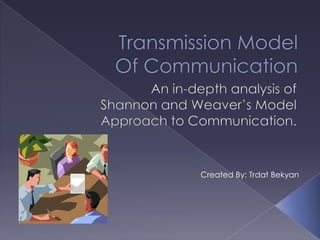Speech 104 extra credit trdat bekyan
•Download as PPTX, PDF•
2 likes•2,320 views
Report
Share
Report
Share

Recommended
More Related Content
What's hot
What's hot (20)
DEFINITION OF COMMUNICATION ELEMENTS/ STAGES OF COMMUNICATION

DEFINITION OF COMMUNICATION ELEMENTS/ STAGES OF COMMUNICATION
Process of communication || Communication Skills || By Dr. Anukriti Sharma

Process of communication || Communication Skills || By Dr. Anukriti Sharma
Communication process and elements of communication [Lab1]![Communication process and elements of communication [Lab1]](data:image/gif;base64,R0lGODlhAQABAIAAAAAAAP///yH5BAEAAAAALAAAAAABAAEAAAIBRAA7)
![Communication process and elements of communication [Lab1]](data:image/gif;base64,R0lGODlhAQABAIAAAAAAAP///yH5BAEAAAAALAAAAAABAAEAAAIBRAA7)
Communication process and elements of communication [Lab1]
Interactive English: Listening, Speaking and Grammar- THE COMMUNICATION PROCESS

Interactive English: Listening, Speaking and Grammar- THE COMMUNICATION PROCESS
Communication Process, Types and Models of Communication

Communication Process, Types and Models of Communication
Similar to Speech 104 extra credit trdat bekyan
Similar to Speech 104 extra credit trdat bekyan (20)
Recently uploaded
https://app.box.com/s/x7vf0j7xaxl2hlczxm3ny497y4yto33i80 ĐỀ THI THỬ TUYỂN SINH TIẾNG ANH VÀO 10 SỞ GD – ĐT THÀNH PHỐ HỒ CHÍ MINH NĂ...

80 ĐỀ THI THỬ TUYỂN SINH TIẾNG ANH VÀO 10 SỞ GD – ĐT THÀNH PHỐ HỒ CHÍ MINH NĂ...Nguyen Thanh Tu Collection
Recently uploaded (20)
Unit 3 Emotional Intelligence and Spiritual Intelligence.pdf

Unit 3 Emotional Intelligence and Spiritual Intelligence.pdf
Kodo Millet PPT made by Ghanshyam bairwa college of Agriculture kumher bhara...

Kodo Millet PPT made by Ghanshyam bairwa college of Agriculture kumher bhara...
HMCS Max Bernays Pre-Deployment Brief (May 2024).pptx

HMCS Max Bernays Pre-Deployment Brief (May 2024).pptx
ICT role in 21st century education and it's challenges.

ICT role in 21st century education and it's challenges.
Salient Features of India constitution especially power and functions

Salient Features of India constitution especially power and functions
Micro-Scholarship, What it is, How can it help me.pdf

Micro-Scholarship, What it is, How can it help me.pdf
On National Teacher Day, meet the 2024-25 Kenan Fellows

On National Teacher Day, meet the 2024-25 Kenan Fellows
80 ĐỀ THI THỬ TUYỂN SINH TIẾNG ANH VÀO 10 SỞ GD – ĐT THÀNH PHỐ HỒ CHÍ MINH NĂ...

80 ĐỀ THI THỬ TUYỂN SINH TIẾNG ANH VÀO 10 SỞ GD – ĐT THÀNH PHỐ HỒ CHÍ MINH NĂ...
Speech 104 extra credit trdat bekyan
- 1. Transmission Model Of Communication An in-depth analysis of Shannon and Weaver’s Model Approach to Communication. Created By: Trdat Bekyan
- 2. Table of Contents Introduction to the Transmission Model of Communication. Sender Encoding Message Channel Receiver Decoding Feedback Noise Conclusion to the Transmission Model of Communication. The End
- 3. Introduction to the Transmission Model of Communication One very important aspect about communicationis that it is impossible not to communicate! Communication is all about sending and receiving messages that can be altered by noise and given feedback. A message starts at an information basis which is transmitted and sent to a receiver. During this time, the message can interfere with noises, and finally be given back with feedback.
- 4. Sender The Sender holds the source of the message and is accountable for the success or failure in communicating. The Sender has more control of the act than the receiver.
- 5. Encoding Encoding is the procedure where the source takes the idea and applies symbols that can be verbal or nonverbal to send which correspond to the idea. Culture, gender, expectations, language, etc. can all play a huge part in the procedure of encoding.
- 6. Message The Message is what the sender wants the audience to know and is the actual content. Sentence structure, spelling, grammar, etc., are all aspects of a message.
- 7. Channel Messages must pass through a medium called Channel. The Channels of communication consist of sight, sound, touch, taste, and smell. Channels can affect communication greatly and must be chosen carefully. Writing a letter, sending flowers, or talking to a person are all different mediums.
- 8. Receiver The Receiver is the audience of the message. There could be a primary audience, who the message is for, or secondary audience, surrounding people who see/hear the communication.
- 9. Decoding Decoding is the skill of translating the message into symbols. It is difficult to understand the message exactly the same way the sender sent it because they are not identical. We can only wish it comes as close. Culture, gender, expectations, language, etc. that all affected encoding, can also affect decoding.
- 10. Feedback Feedback is the information that is sent back. Feedback can tell the Sender how you have decoded it by the way you respond to it.
- 11. Noise Noise can happen at any time during communication. It also disrupts or distorts the process. It could be physical or psychological.
- 12. Conclusion to the Transmission Model of Communication We must remember, “Communication effectiveness depends on the successful integration of all the parts of the process.”
- 13. Created By: Trdat Bekyan